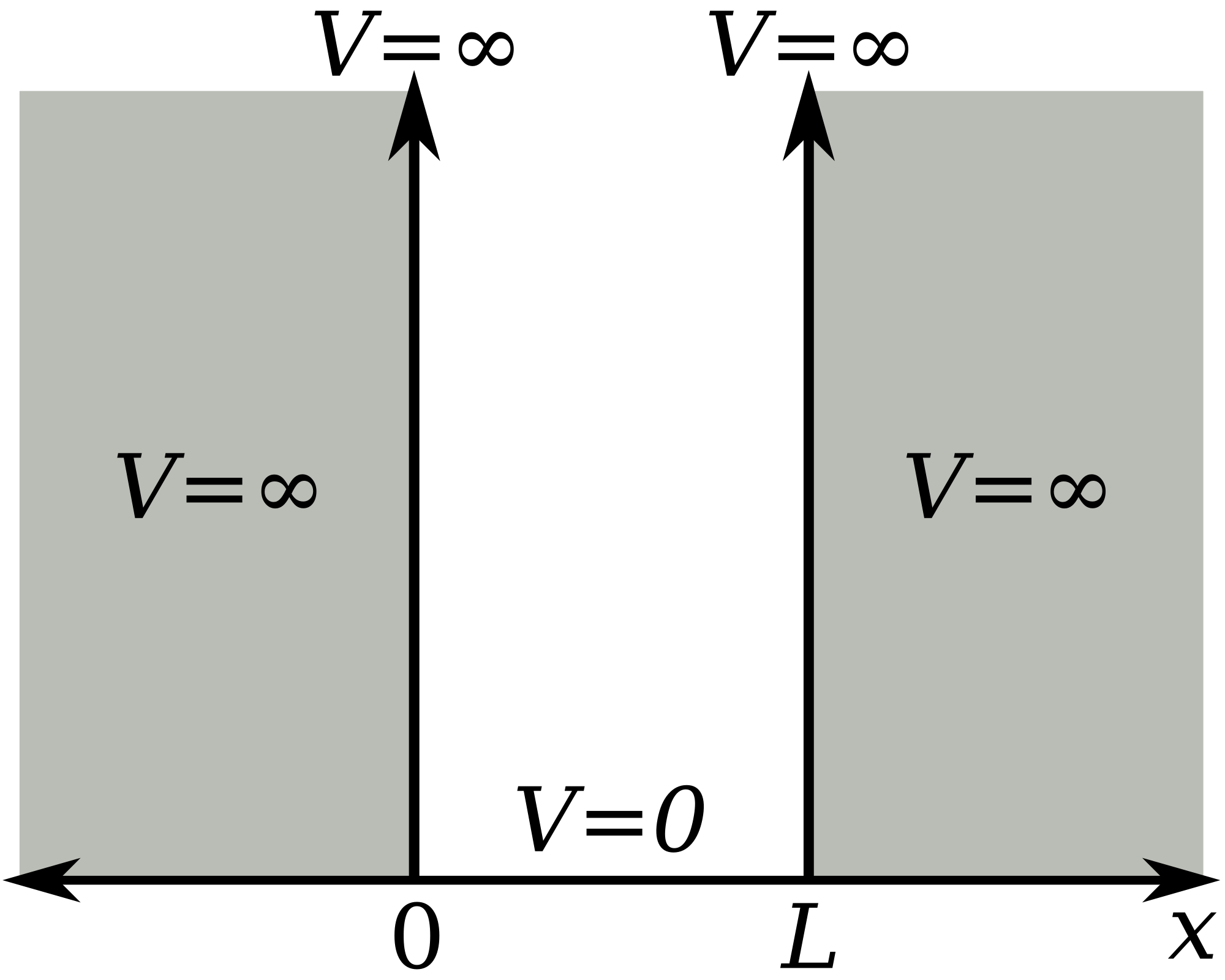# nbi:hide_in
import nbinteract as nbi
import numpy as np
import scipy as sp
The particle in a box in 1D¶
Here's a quick reminder of the particle in a box

Schrödinger equation (SE): $\hat{H}\psi = E\psi $
SE: action of energy operator $\hat{H}$ defines the energy and wave function $\psi$
$$ \hat{H} = -\frac{\hbar^2}{2m}\frac{d^2}{dx^2} +V $$
boundary conditions: $ \psi(0) = 0 \quad\text{and}\quad \psi(L) = 0 $
wave function
$$ \psi_n(x) = \sqrt{\frac{2}{L}}\sin{\frac{n\pi x}{L}} $$
energies
$$ E_n = \frac{\hbar^2\pi^2}{2m}\frac{n^2}{L^2} $$
# nbi:hide_in
def make_xgrid(start, stop, N):
x = np.linspace(start,stop,N)
return x
# nbi:hide_in
def potential(x, box_l=0.0, box_r=5.0, height=100000.0):
pot = np.zeros_like(x) #isn't numpy great? This generates an array with zeros, which has the same shape like x
for i, xvalue in enumerate(x): #we loop through all x values
#enumerate is really nice.
#It allows us to loop through an array and, for each value, gives us an index i and the actual xvalue
if (xvalue<box_l): #left wall
pot[i] = height
elif (xvalue> box_l and xvalue < box_r): #inside the box
pot[i] = 0.0
elif (xvalue>box_r): #right wall
pot[i] = height
else:
raise ValueError("COMPUTER SAYS NO. This point should never be reached.")
return pot
# nbi:hide_in
def create_H(x, pot):
hbar = 1
m = 1
dx = x[1]-x[0]
import scipy.ndimage
L = scipy.ndimage.laplace(np.eye(len(x)), mode='wrap')/(2.0*dx*dx) #np.eye is a diagonal unit matrix (I) with size 'x' by 'x'
T= -(1./2.)*((hbar**2)/m)*L
V = np.diag(pot) #np.diag takes a list of numbers and puts it onto the diagonal; the offdiagonals are 0
H = T+V
return H
# nbi:hide_in
def diagonalise_H(H):
import scipy.linalg as la
E, psi = la.eigh(H)
return E, psi
# nbi:hide_in
#### %matplotlib notebook
%matplotlib inline
import matplotlib.pyplot as plt
from ipywidgets import interact, interactive, fixed, interact_manual
def plot_pib1d(x, pot, E, psi, n=0):
"""
plots the energies, the wave function and the probability density with interactive handles.
"""
n=n-1
import matplotlib.gridspec as gridspec
plt.figure(figsize=(11, 8), dpi= 80, facecolor='w', edgecolor='k') # figsize determines the actual size of the figure
gs1 = gridspec.GridSpec(2, 3)
gs1.update(left=0.05, right=0.90, wspace=0.35,hspace=0.25)
ax1 = plt.subplot(gs1[: ,0])
ax2 = plt.subplot(gs1[0, 1:])
ax3 = plt.subplot(gs1[1, 1:])
ax1.plot(x, pot, color='gray')
ax1.plot(np.ones(len(E)), E, lw=0.0, marker='_',ms=4000, color='blue')
ax1.plot(1, E[n], lw=0.0, marker='_',ms=4000, color='red')
ax1.set_ylim(-1,21)
ax2.plot(x, psi[:,n])
ax3.plot(x, psi[:,n]*psi[:,n])
#figure out boundaries
start=0; stop=0
for i, p in enumerate(pot):
if (p>-0.001 and p<0.001):
start=x[i-1]
break
for i, p in enumerate(pot):
if (p>-0.001 and p<0.001):
stop=x[i+1]
ax2.axvline(start, color='gray')
ax2.axvline(stop, color='gray')
ax3.axvline(start, color='gray')
ax3.axvline(stop, color='gray')
ax3.axhline(0.0,color='gray')
#Labeling of x and y axes
ax1.set_xlabel('x',fontsize=14)
ax1.set_ylabel('Energy [eV]',fontsize=14)
ax2.set_ylabel(r'wave function $\psi(x)$',fontsize=14)
ax3.set_ylabel(r'density $|\psi|^2$(x)',fontsize=14)
ax2.set_xlabel(r'x',fontsize=14)
ax3.set_xlabel(r'x',fontsize=14)
#Show the final result
plt.show()
return plot_pib1d
# nbi:hide_in
def pib1d(N=100, box_l=0.0, box_r=5.0, height=100000.0, n=0):
"""
calculates and visualises the energies and wave functions of the 1d particle in a box
This program takes the number of grid points and the start and end point of the box as arguments and
returns a visualisation.
"""
#make an x axis
x = make_xgrid(box_l-1.0,box_r+1.0,N)
#create a box potential on that axis
pot = potential(x,box_l, box_r, height)
#calculate Hamiltonian
H = create_H(x,pot)
#diagonalise Hamiltonian, solve for E and psi
E, psi = diagonalise_H(H)
plot_pib1d(x, pot, E, psi, n)
#If the function doesn't have a return value and simply executes a number of commands,
#we simply return the logical value true when everything ran smoothly to the end
return pib1d
# nbi:hide_in
#plot results
N = 100
box_l = 0.0
box_r = 5.0
height = 100000.0
#pib1d(N,box_l,box_r, height)
interact(pib1d, N=fixed(N), box_l=fixed(box_l), box_r=(1.0,10.0), height=(0.,10000,10), n=range(1,21))
The particle in a slanted box¶
# nbi:hide_in
#potential function
def tilted_potential(x, box_l=0.0, box_r=5.0, height=100000.0, grad=1.0):
pot = np.zeros_like(x) #isn't numpy great? This generates an array with zeros, which has the same shape like x
for i, xvalue in enumerate(x): #we loop through all x values
#enumerate is really nice.
#It allows us to loop through an array and, for each value, gives us an index i and the actual xvalue
if (xvalue<box_l): #left wall
pot[i] = height
elif (xvalue> box_l and xvalue < box_r): #inside the box
pot[i] = xvalue*grad
elif (xvalue>box_r): #right wall
pot[i] = height
else:
raise ValueError("COMPUTER SAYS NO. This point should never be reached.")
return pot
#new main program where we replaced the potential
def tilted_pib(N,box_l=0.0,box_r=5.0, height=10000.0,n=1, grad=1.0):
x = make_xgrid(box_l-1.0,box_r+1.0,N)
######ONLY THE FOLLOWING LINES ARE DIFFERENT
x0 = (box_l+box_r)/2 #define the centre of the harmonic oscillator in the middle of the box
pot = tilted_potential(x, box_l, box_r, height, grad)
######END OF DIFFERENCE##########
H = create_H(x,pot)
E, psi = diagonalise_H(H)
plot_pib1d(x, pot, E, psi, n)
return tilted_pib
# nbi:hide_in
#plot results
N = 100
box_l = 0.0
box_r = 5.0
height = 100000.0
#pib1d(N,box_l,box_r, height)
interact(tilted_pib, N=fixed(N), box_l=fixed(box_l), box_r=fixed(box_r), height=fixed(height), n=range(1,20), grad=(0.,10.))
The Harmonic oscillator¶
# nbi:hide_in
#potential function
def harmonic_potential(x, x0=2.5, k=10.):
"""
Function calculates harmonic potential on x-axis centred around x0 with spring constant k
"""
return 0.5*k*(x-x0)*(x-x0)
#new main program where we replaced the potential
def HO1D(N,box_l,box_r, k=10.0, n=0):
x = make_xgrid(box_l-1.0,box_r+1.0,N)
######ONLY THE FOLLOWING LINES ARE DIFFERENT
x0 = (box_l+box_r)/2 #define the centre of the harmonic oscillator in the middle of the box
pot = harmonic_potential(x, x0, k)
######END OF DIFFERENCE##########
H = create_H(x,pot)
E, psi = diagonalise_H(H)
plot_pib1d(x, pot, E, psi, n)
return HO1D
# nbi:hide_in
#Number of grid points
N = 100
box_l = 0.0
box_r = 5.0
height = 10.0
interact(HO1D, N=fixed(N),box_l=fixed(box_l),box_r = fixed(box_r),k=(1.,100.), n=range(1,20))